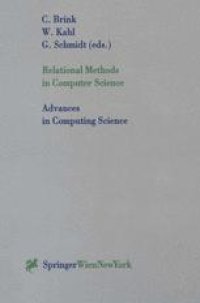
Ebook: Relational Methods in Computer Science
- Tags: Arithmetic and Logic Structures, Logics and Meanings of Programs, Mathematical Logic and Formal Languages, Mathematics of Computing
- Series: Advances in Computing Sciences
- Year: 1997
- Publisher: Springer-Verlag Wien
- Edition: 1
- Language: English
- pdf
The calculus of relations has been an important component of the development of logic and algebra since the middle of the nineteenth century, when Augustus De Morgan observed that since a horse is an animal we should be able to infer that the head of a horse is the head of an animal. For this, Aristotelian syllogistic does not suffice: We require relational reasoning. George Boole, in his Mathematical Analysis of Logic of 1847, initiated the treatment of logic as part of mathematics, specifically as part of algebra. Quite the opposite conviction was put forward early this century by Bertrand Russell and Alfred North Whitehead in their Principia Mathematica (1910 - 1913): that mathematics was essentially grounded in logic. Logic thus developed in two streams. On the one hand algebraic logic, in which the calculus of relations played a particularly prominent part, was taken up from Boole by Charles Sanders Peirce, who wished to do for the "calculus of relatives" what Boole had done for the calculus of sets. Peirce's work was in turn taken up by Schroder in his Algebra und Logik der Relative of 1895 (the third part of a massive work on the algebra of logic). Schroder's work, however, lay dormant for more than 40 years, until revived by Alfred Tarski in his seminal paper "On the calculus of binary relations" of 1941 (actually his presidential address to the Association for Symbolic Logic).
The calculus of relations turned into an important conceptual and methodological tool in computer science. The methods presented in this book include questions of relational databases, applications to program specification, resource-conscious linear logic, semantic and refinement consideration, nonclassical logics for reasoning about programs, tabular methods in software construction, algorithm development, linguistic problems, followed by a comprehensive bibliography. The reader gets an overview of the wide-ranging applicability of relational methods in computer science. "... While this is a multi-authored volume, the authors have done an excellent job of making it read like a single-authored work ... The book can be viewed as a set of snapshots of a family of research and researchers at one point in time. If you are interested in relational problems, I can think of no better introduction ...” Computing Reviews
The calculus of relations turned into an important conceptual and methodological tool in computer science. The methods presented in this book include questions of relational databases, applications to program specification, resource-conscious linear logic, semantic and refinement consideration, nonclassical logics for reasoning about programs, tabular methods in software construction, algorithm development, linguistic problems, followed by a comprehensive bibliography. The reader gets an overview of the wide-ranging applicability of relational methods in computer science. "... While this is a multi-authored volume, the authors have done an excellent job of making it read like a single-authored work ... The book can be viewed as a set of snapshots of a family of research and researchers at one point in time. If you are interested in relational problems, I can think of no better introduction ...” Computing Reviews
Content:
Front Matter....Pages i-xv
Background Material....Pages 1-21
Relation Algebras....Pages 22-38
Heterogeneous Relation Algebra....Pages 39-53
Fork Algebras....Pages 54-69
Relation Algebra and Modal Logics....Pages 70-89
Relational Formalisation of Nonclassical Logics....Pages 90-105
Linear Logic....Pages 106-114
Relational Semantics of Functional Programs....Pages 115-130
Algorithms from Relational Specifications....Pages 131-149
Programs and Datatypes....Pages 150-165
Refinement and Demonic Semantics....Pages 166-183
Tabular Representations in Relational Documents....Pages 184-196
Databases....Pages 197-210
Logic, Language, and Information....Pages 211-225
Natural Language....Pages 226-246
Back Matter....Pages 247-275
The calculus of relations turned into an important conceptual and methodological tool in computer science. The methods presented in this book include questions of relational databases, applications to program specification, resource-conscious linear logic, semantic and refinement consideration, nonclassical logics for reasoning about programs, tabular methods in software construction, algorithm development, linguistic problems, followed by a comprehensive bibliography. The reader gets an overview of the wide-ranging applicability of relational methods in computer science. "... While this is a multi-authored volume, the authors have done an excellent job of making it read like a single-authored work ... The book can be viewed as a set of snapshots of a family of research and researchers at one point in time. If you are interested in relational problems, I can think of no better introduction ...” Computing Reviews
Content:
Front Matter....Pages i-xv
Background Material....Pages 1-21
Relation Algebras....Pages 22-38
Heterogeneous Relation Algebra....Pages 39-53
Fork Algebras....Pages 54-69
Relation Algebra and Modal Logics....Pages 70-89
Relational Formalisation of Nonclassical Logics....Pages 90-105
Linear Logic....Pages 106-114
Relational Semantics of Functional Programs....Pages 115-130
Algorithms from Relational Specifications....Pages 131-149
Programs and Datatypes....Pages 150-165
Refinement and Demonic Semantics....Pages 166-183
Tabular Representations in Relational Documents....Pages 184-196
Databases....Pages 197-210
Logic, Language, and Information....Pages 211-225
Natural Language....Pages 226-246
Back Matter....Pages 247-275
....